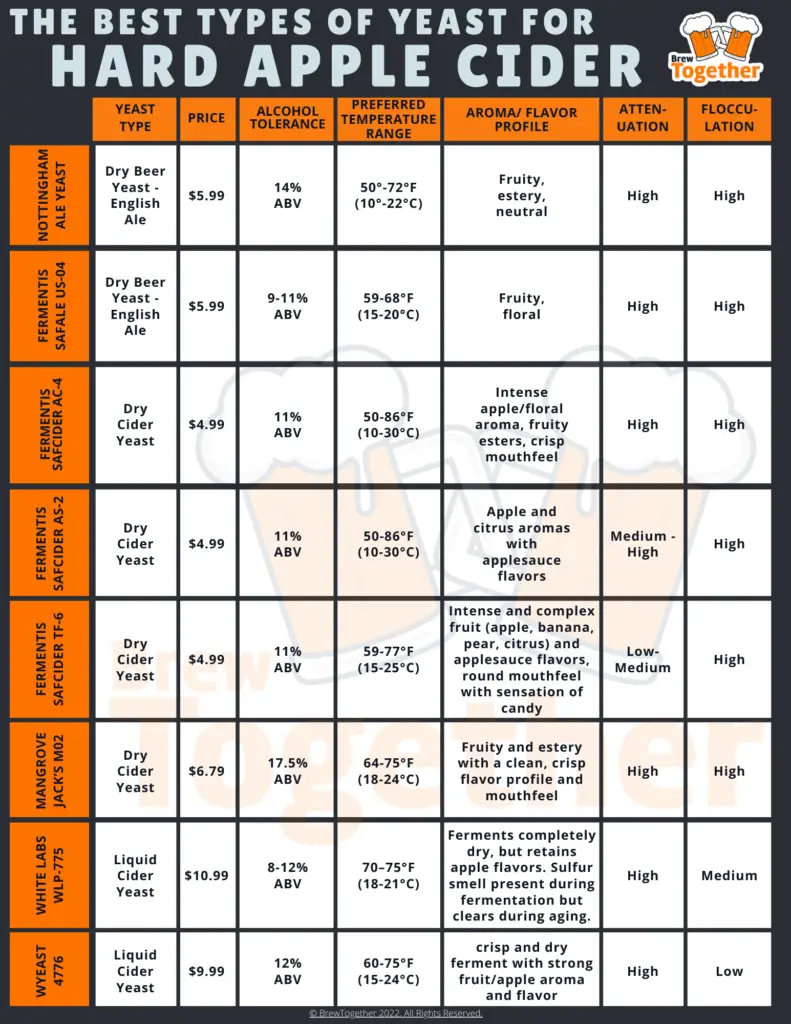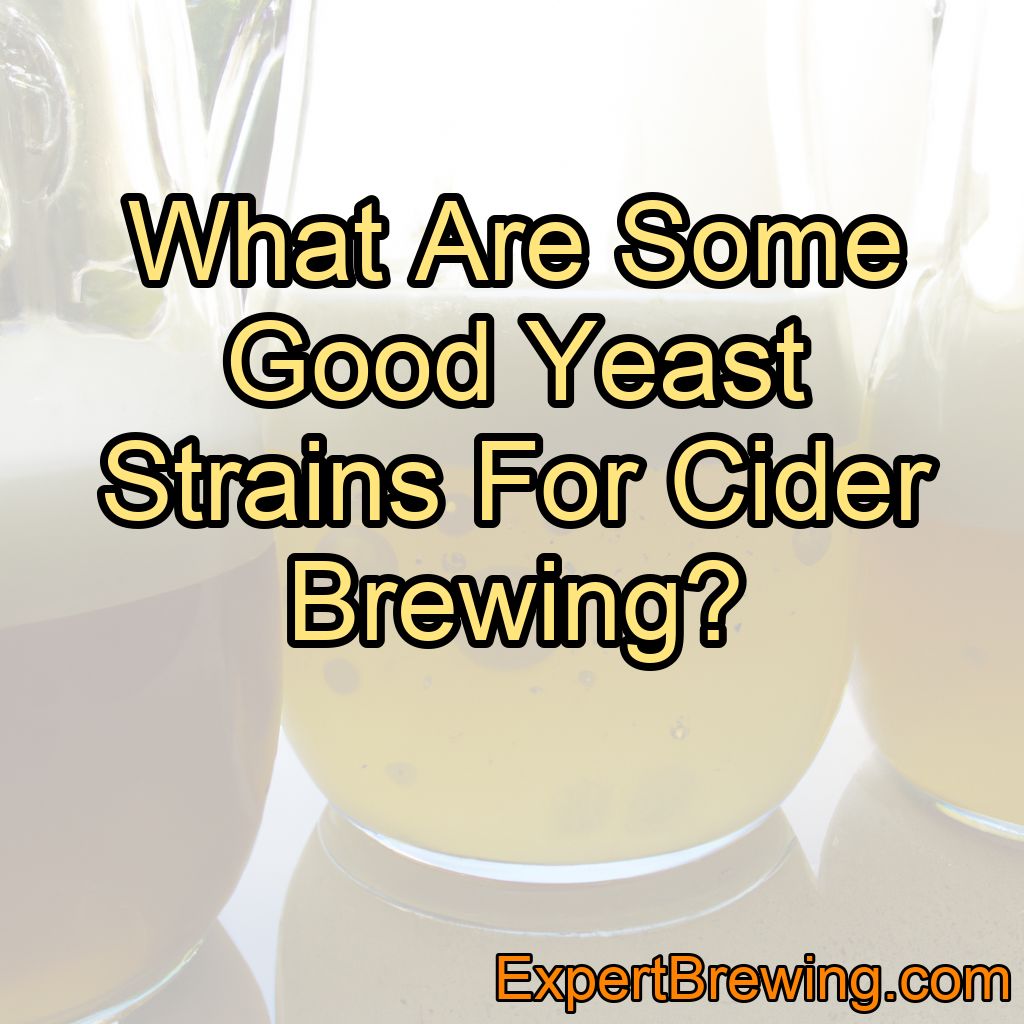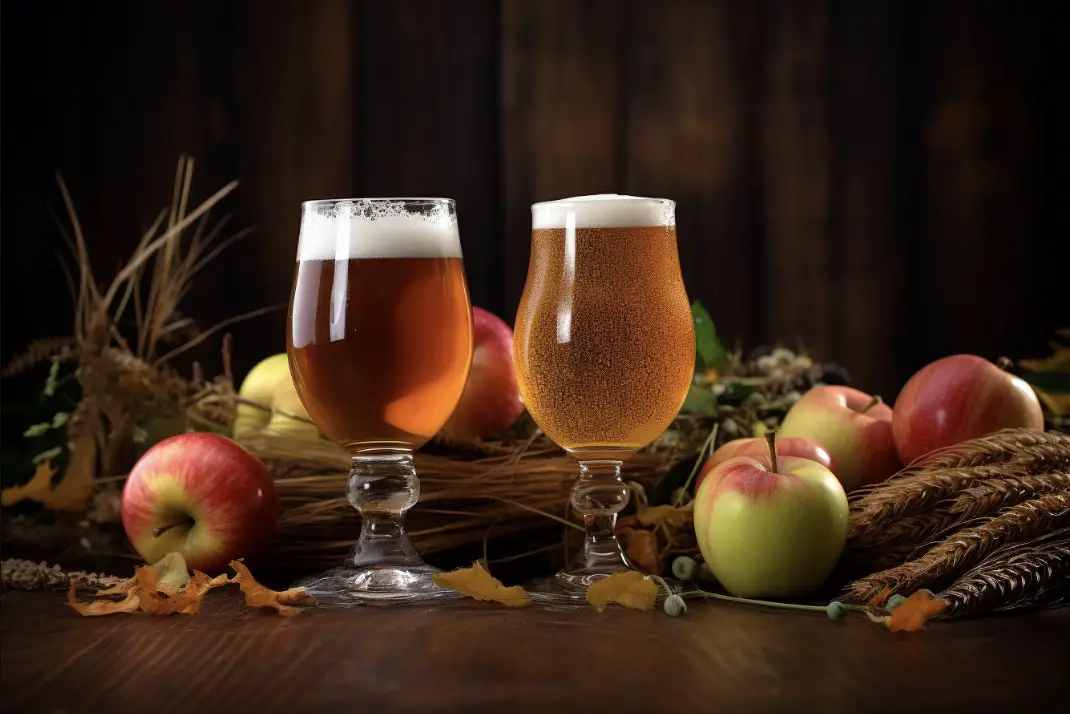Cider brewing is an art that requires the perfect balance of flavors and fermentation to create a delicious and refreshing beverage. One of the key components in cider brewing is the yeast strain used, as it can drastically affect the taste and characteristics of the final product.
Some good yeast strains for cider brewing include: Champagne yeast, English Ale yeast, Saison yeast, German Wheat Beer yeast, and fruit wine yeast.
Our recommended list for cider includes popular strains like:
- Mangrove Jacks’s M02
- Fermentis SafCider yeasts
- Lavin EC-118 yeast
- Red Star Premier Blanc Champagne Yeast
- Red Star Premier Classique Wine Yeast
- Cider House Select Cider Yeast
- Safale S-04
- and White Labs WLP001
In this blog post, we will explore the characteristics of these yeast strains and their impact on cider brewing.
What Are the Best Commercial Yeasts Available?
Commercial yeasts specifically designed for making hard cider are available from many homebrew suppliers online or at local stores specializing in home brewing supplies.
Scroll to the end of this article to see a complete table of the 20 most popular yeasts available to home brewers and their stats!
These come pre-measured in small packets or jars that contain enough yeast cells needed for 5 gallons (19 liters) of juice – usually around 100 billion cells per gram depending on the strain chosen – so there’s no need to worry about measuring out individual doses yourself when using these products.
The process of fermentation is key to many beloved alcoholic beverages. The right yeast can make all the difference in terms of flavor, aroma, and mouthfeel.
But with so many commercial yeasts on the market, it can be hard to know where to start.
Here are five of the best commercial yeasts available for making beer, wine, cider, champagne, and more:
1. White Wine Yeast – For a classic and clean fermenting experience that will produce dry wines with good acidity levels, try:
Lalvin Premier Blanc Champagne Yeast or Red Star Premier Classique Wine Yeast.
Both are great options for cider making as they ferment with a clean taste and precipitate nicely when done to clear the cider.
2. Champagne Yeast – Numerous options for a strongly carbonated cider.
Try using a true champagne yeast like Lavin EC-118, Red Star or Moreau & Fils Cuvée Spéciale Crémant de Loire Brut Nature. These strains are designed specifically for producing sparkling wines and champagnes with plenty of fizziness and complexity.
Especially the Lalvin EC-1118 is great for most high alcohol and champagne-like ciders with a dry but clean and smooth acidic finish.
I have used it many times for my hard-to-ferment juices and to restart stuck fermentations.
3. Beer Yeast – There are Many Different Strains of Beer Yeast Available on the Market, So It Really Depends on What Style of Beer You’re Trying to Make.
For a traditional American ale, try White Labs WLP001 California Ale Yeast or Fermentis Safale US-05 Dry Brewing Yeast.
If you’re looking to brew a German lager, go with Weihenstephaner Hefeweissbier Dunkel or Wyeast Activator 1084.
They work especially well for hopped-cider varieties and those where malt has been added!
4. Cider Yeasts – The real deal!
Most cider makers are using a champagne yeast like Lalvin EC-1118 or going with a “real” cider yeast like the classical Mangrove Jacks M02 or the Fermentis Safcider yeast strain.
These cider yeasts produce a good amount of aromatic esters that add to the complexity and fruity notes of your cider.
I’ve used both extensively and had really great results with both. I prefer the M02 for sweeter ciders and the Safcider yeast for the more dry, champagne-like, ones.
Both will give your cider plenty of carbonation and alcohol content, but the wild yeast option will also add some funky flavors that can complement the sweetness of the apples nicely.
5. Wild Yeasts – Finally, if you’re feeling adventurous and want to experiment with fermentation beyond the standard winebeercider yeasts mentioned above, consider playing around with some wild yeasts !
These naturally occurring microbes can be found just about anywhere (including on fruits and in flower blossoms), so all you need is an open mind and willingness to let nature take its course.
Some popular strains include Saccharomyces cerevisiae var.diaemath, Brettanomyces bruxellensis ,and Rhodotorula rubra , but there are literally hundreds more out there waiting to be discovered…Happy fermenting!
Main Takeaway: Different types of yeast produce different types of alcohol.

What Cider Yeast Is Best For You?
As a home brewer, you have many options when it comes to choosing yeast for your cider. The type of yeast you choose will impact the flavor, mouthfeel, and overall quality of your cider.
Here are some things to consider when choosing yeast for your next batch:
1. What style of cider are you making?
Different styles of cider require different types of yeasts. For example, if you’re making a dry apple cider, then you’ll want to use a neutral-flavored or low-phenol strain of yeast.
However, if you’re making an English-style sweet or fruit forward ciders, then using traditional English strains with higher phenols will be more appropriate.
2. Consider What Flavors and Aromas You Want in Your Finished Product
For instance, if you want a crisp and dry cider with no secondary fermentation aromas like banana or clove, then using a white labs strain like the WLP775 Czech Pilsner will get you that result.
On the other hand, if you are looking for a full bodied and fruity cider then something like Red Star Premier Cuvee would work well.
There are many other factors that can impact the final flavor of your cider so always do experimentation to test what works best for you!
3. How much time do you have?
Some strains of yeast work faster than others – meaning that they ferment out completely in less time (usually around 2 weeks). Other strains may take longer (3-4 weeks) but can produce better results in terms of flavor development and complexity.
In general, most commercial brewers favor faster working yeasts as it’s easier to predict their behavior and manage fermentation times.
However, if you have patience and don’t mind waiting a bit longer for the finished product, then slower working yeasts may be a preference for this case.
4. What is your budget?
There are many different brands and strains of yeast available on the market, and they can vary widely in price.
Some home brewers prefer to use more expensive liquid cultures, while others are perfectly happy using dry yeasts that cost a fraction of the price.
It really comes down to personal preference – so find what works best for you and your budget.
5. Do you have any special needs or considerations?
Be sure to consider any dietary restrictions or allergies when choosing a yeast strain. Choosing the right type of yeast is an important part of making great cider at home.
Similarly, if you’re making cider for someone who is lactose intolerant, then using a lacto-fermenting yeast strain may not be appropriate.
By considering the style of cider you want to make, desired flavors and aromas, fermentation time, and budget, you can find the perfect yeast for your next batch!
Main Takeaway: The type of yeast you use will impact the flavor, mouthfeel, and overall quality of your cider.
Champagne Yeast
Champagne yeast is a popular choice for cider brewing due to its high alcohol tolerance and ability to ferment a wide range of sugars. This yeast strain produces a clean, crisp, and dry cider with subtle fruity flavors.
Pros:
- High alcohol tolerance
- Ferments a wide range of sugars
- Produces a clean, crisp, and dry cider
Cons:
- Can strip away some of the apple flavor in the final product
- May produce a higher alcohol content than desired for some cider styles

English Ale Yeast
English Ale yeast strains are known for their fruity esters and ability to produce a well-rounded, full-bodied cider. This yeast strain is often used in traditional British-style ciders and provides a more complex flavor profile than champagne yeast.
Pros:
- Produces a well-rounded, full-bodied cider
- Fruity esters add complexity to the final product
- Ideal for traditional British-style ciders
Cons:
- May not ferment as quickly as other yeast strains
- Can sometimes produce a higher level of diacetyl, which may be undesirable in some ciders
Saison Yeast
Saison yeast strains are known for their spicy and fruity characteristics, making them an interesting option for cider brewing. This yeast strain can produce a unique and flavorful cider with a dry finish.
Pros:
- Adds spicy and fruity characteristics to the final product
- Produces a dry finish
- Can ferment at a wide range of temperatures
Cons:
- May not be suitable for all cider styles
- Can sometimes produce a higher level of phenols, which may be undesirable in some ciders
German Wheat Beer Yeast
German Wheat Beer yeast strains, such as Weihenstephan or Munich, are known for their fruity esters and phenolic compounds. These yeast strains can produce a cider with banana and clove-like flavors, making for a unique and interesting final product.
Pros:
- Produces fruity esters and phenolic compounds
- Can create a unique and interesting flavor profile
- Ideal for those looking to experiment with different cider flavors
Cons:
- May not be suitable for all cider styles
- Can sometimes produce a higher level of phenols, which may be undesirable in some ciders
Fruit Wine Yeast
Fruit wine yeast strains, such as Montrachet or Premier Cuvee, are specifically designed for fermenting fruit juices and can produce a clean and crisp cider with a good balance of apple flavor and acidity.
Pros:
- Designed for fermenting fruit juices
- Produces a clean and crisp cider
- Maintains a good balance of apple flavor and acidity
Cons:
- May not ferment as quickly as other yeast strains
- Can sometimes produce a higher level of sulfur compounds, which may be undesirable in some ciders
Cider House Select Yeast
Cider House Select yeast is specifically designed for cider brewing and can produce a clean, crisp, and well-rounded cider. This yeast strain is versatile and can be used with various types of apples to create unique and flavorful ciders.
Pros:
- Specifically designed for cider brewing
- Produces a clean, crisp, and well-rounded cider
- Versatile and can be used with various types of apples
Cons:
- Can sometimes produce a higher level of sulfur compounds, which may be undesirable in some ciders
- May not be as readily available as other yeast strains
Wild Yeast
Some cider brewers prefer to use wild yeast, which naturally occurs on the surface of apples and in the surrounding environment. This method can produce a unique and complex cider with a variety of flavors and characteristics. However, using wild yeast can be unpredictable and may not always produce consistent results.
Pros:
- Produces a unique and complex cider
- Can create a variety of flavors and characteristics
Cons:
- Unpredictable and may not produce consistent results
- Can sometimes result in off-flavors or spoilage
Custom Yeast Blends
Many cider brewers choose to create custom yeast blends by combining two or more yeast strains. This allows for greater control over the flavor profile and characteristics of the final product. Experimenting with different yeast combinations can result in a unique and personalized cider.
Pros:
- Allows for greater control over the flavor profile and characteristics
- Can create a unique and personalized cider
Cons:
- Requires experimentation and trial-and-error to find the perfect blend
- Can be more time-consuming and labor-intensive than using a single yeast strain
Conclusion
In conclusion, some good yeast strains for cider brewing include Champagne yeast, English Ale yeast, Saison yeast, German Wheat Beer yeast, and fruit wine yeast. Each strain has its own unique characteristics and impact on the final product, allowing for a wide range of flavors and styles. When choosing a yeast strain for cider brewing, consider the desired flavor profile, fermentation speed, and other factors that may influence the final product. Additionally, don’t be afraid to experiment with different strains and combinations to create a truly unique and delicious cider.
10 Facts about Yeast Strains for Cider Brewing:
1. Champagne yeast produces a clean, crisp, and dry cider.
2. English Ale yeast strains are ideal for traditional British-style ciders.
3. Saison yeast strains add spicy and fruity characteristics to the final product.
4. German Wheat Beer yeast strains can produce banana and clove-like flavors in cider.
5. Fruit wine yeast strains maintain a good balance of apple flavor and acidity.
6. Cider House Select yeast is specifically designed for cider brewing.
7. Wild yeast can produce a unique and complex cider, but with unpredictable results.
8. Custom yeast blends allow for greater control over the flavor profile and characteristics.
9. Experimentation and trial-and-error are key to finding the perfect yeast strain for your cider.
10. The choice of yeast strain can drastically affect the taste and characteristics of the final product.
FAQs
Does yeast make a difference in brewing?
Yes, yeast plays a crucial role in brewing as it is responsible for converting sugars into alcohol and carbon dioxide, determining the flavor, aroma, and mouthfeel of the final product. Different strains of yeast can produce different flavors and aromas, allowing brewers to create a wide range of beer styles.
What is the best yeast for cider homebrew?
The best yeast for cider homebrew depends on the desired flavor profile and style of cider. Some popular options include champagne yeast, ale yeast, and cider-specific yeast strains such as Lalvin EC-1118 or White Labs WLP775.
What kind of yeast do you use for cider?
For cider, you can use wine yeast or cider yeast strains such as Saccharomyces cerevisiae or Saccharomyces bayanus.
Does yeast type matter for brewing?
Yes, yeast type matters for brewing as different strains of yeast can produce different flavors, aromas, and alcohol content in the finished beer. The choice of yeast can also affect the fermentation process and the overall quality of the beer.
How much does yeast affect beer flavor?
Yeast plays a significant role in determining the flavor profile of beer, as it produces various flavor compounds during fermentation. Different strains of yeast can produce distinct flavors, such as fruity, spicy, or earthy notes.
What yeast strain is best for fermentation?
There is no one “best” yeast strain for fermentation as it depends on the specific type of fermentation desired and the characteristics of the ingredients being used. Different yeast strains have different temperature and nutrient requirements, as well as varying abilities to produce desired flavors and aromas. It is important to choose a yeast strain that is appropriate for the specific fermentation conditions and desired outcome.












